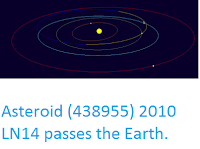Asteroid
2017 BR5 passed by the Earth at a distance of 811 000 km (2.11 times
the
average distance between the Earth and the Moon, 0.54% of the average
distance
between the Earth and the Sun), slightly before 5.30 am GMT on Sunday 22
January 2017. There was no danger of the asteroid hitting us, though
had it
done so it would have presented no threat. 2017 BR5 has an estimated
equivalent diameter of 5-18 m (i.e. it is estimated that a spherical
object
with the same volume would be 5-18 m in diameter), and an object of
this
size
would be expected to explode in an airburst (an explosion caused by
superheating from friction with the Earth's atmosphere, which is greater
than
that caused by simply falling, due to the orbital momentum of the
asteroid) in
the atmosphere between 40 and 25 km above the ground, with only
fragmentary
material reaching the Earth's surface.
The calculated orbit of 2017 BR5. Minor Planet Center.
three days after
2017 BR5 was discovered on 25 January 2017 (eight days before its closest approach to the Earth) by the Defense Advanced Research Projects Agency's Space Surveillance Telescope.
The designation 2017 BR5 implies that it was the 142nd asteroid
(asteroid R5) discovered in the second half of January 2017 (period
2017 B).
2017 BR5 is calculated to have a 833 day orbital
period and an elliptical orbit tilted at an angle of 5.39° to the plain of the
Solar System that takes it from 0.89 AU from the Sun (i.e. 89% of the average
distance at which the Earth orbits the Sun) to 2.57 AU from the Sun (i.e. 257%
of the average distance at which the Earth orbits the Sun, considerably more than at which the planet Mars orbits the Sun). It is therefore classed as
an Apollo Group Asteroid (an asteroid that is on average further from the Sun
than the Earth, but which does get closer). This means that the asteroid has occasional close encounters with the Earth, with the last having occurred
in February 1949.
See also...
Follow Sciency Thoughts on Facebook.







